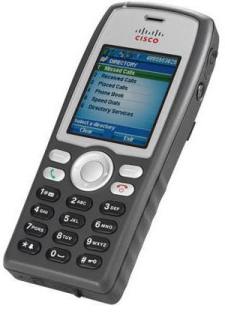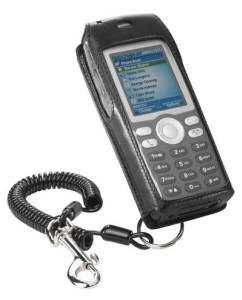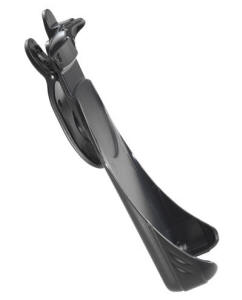| Cisco Unified Wireless IP Phones 7925G Specification |
| Dimensions (H x W x D) |
5.0 x 2.0 x 0.8 in. (12.7 x 5.2 x 2.0 cm) |
| Weight |
3.5 lb (1.6 kg) |
| Battery |
- Standard lithium-ion (Li-ion) battery life: up to 9.5 hours talk time and 180 hours standby
- Extended Li-ion battery life: up to 13 hours talk time and 240 hours standby
- Actual battery life varies significantly based on environmental factors and Bluetooth use
|
| Input Power |
- Phone: 100 to 240 VAC, ~0.2A, and 50 to 60 Hz
- AC adapters (by geographical region)
|
| Vibration |
1.5 Grms maximum, 0.1 in. (2.5 mm) double amplitude at 0.887 octaves per minute from 5-500-5 Hz sweep, and 10-minute dwell on three major peaks in each of the three major mutually perpendicular axes |
| Thermal shock |
-22°F (-30°C) 24 hours; 158°F (70°C) 24 hours |
| Altitude |
Certified for operation: 0 to 6500 ft (0 to 2 km) |
| Endurance |
- IP54
- MIL-STD-810F, Method 516.5, Procedure I
|
| Headset |
- Wireless: Bluetooth 2.0
- Wired: 2.5 mm (4-conductor tri-band)
|
| Connector |
Mini USB |
| Operating temperature |
32 to 104°F (0 to 40°C) |
| Relative humidity |
10 to 95% (noncondensing) |
| Storage temperature |
-22 to 140°F (-30 to 60°C) |
| Safety |
- UL 60950
- CAN/CSA-C22.2 No. 60950
- EN 60950
- IEC 60950
- AS/NZS 60950
- IEC 60529 (IP 54)
|
| Electromagnetic compatibility (EMC) |
- FCC Part 15 (CFR 47) Class B
- ICES-003 Class B
- EN 55022 Class B
- AS/NZS CISPR 22 Class B
- CISPR22 Class B
- VCCI Class B
- EN55024
- EN 61000-3-2
- EN 61000-3-3
- KN 22
- EN 55024
- EN 50082-1
- EN 61000-6-1
- EN 300386
- EN 60601-1-2
- KN Immunity Series
|
| Telecom |
- FCC Part 68 (CFR) (HAC)
- NZ PTC 220 DR
- AS/ACIF S004 and AS/ACIF S040 (Australia)
- TIA 810-B and TIA 920-A
|
| Radio |
- USA: FCC Part 15.247 (2.4 GHz), FCC Part 15.407 (5 GHz), and FCC Part 2
- Canada: RSS-210
- Japan: ARIB STD-T66 (2.4 GHz), and ARIB STD-T70 and T71 (4.9/5 GHz)
- ETSI : EN 300.328 (2.4 GHz) and EN 301.893 (5 GHz)
- Australia and New Zealand: AS/NZS 4268
- Singapore: IDA TS SRD
- Hong Kong: HKTA1039
|
| RF exposure |
- OET-65C (01-01)
- ANSI C95.1 (91)
- RSS-102
- ACA Radio Communications (Electromagnetic Radiation - Human Exposure) Standard 2003
- EN 50360
- EN 301489-1
- EN 301489-17
|
| Protocol |
IEEE 802.11a, 802.11b, and 802.11g |
| Frequency band and operating channels |
FCC: (-A)
- 2.412-2.462 GHz; 11 channels
- 5.15-5.25 GHz Unlicensed National Information Infrastructure (UNII-1), 5.25-5.35 GHz (UNII-2), and 5.725-5.825 GHz (UNII-3); 12 channels
- 5. 47-5.725 GHz; 11 channels
ETSI: (-E)
- 2.412-2.472 GHz; 13 channels
- 5.15-5.725 GHz; 19 channels
Japan: (-P)
- 2.412-2.472 GHz; 13 channels Orthogonal Frequency Division Multiplexing (OFDM)
- 2.412-2.484 GHz; 14 channels Complementary Code Keying (CCK)
- 5.15-5.725 GHz; 19 channels
Rest of World: (-W)
- Uses IEEE 802.11d to identify band ranges and channels
|
| Support mode |
- IEEE 802.11a
- IEEE 802.11b/g
- Autosensing, IEEE 802.11b/g preferred over IEEE 802.11a
- Autosensing, IEEE 802.11a preferred over IEEE 802.11b/g
- Received signal strength indicator (RSSI) (default)
|
| Data rates |
IEEE 802.11a:
6, 9, 12, 18, 24, 36, 48, and 54 Mbps |
IEEE 802.11b:
1, 2, 5.5, and 11 Mbps |
IEEE 802.11g:
6, 9, 12, 18, 24, 36, 48, and 54 Mbps |
| Nonoverlapping channels |
- IEEE 802.11a: Up to 23 (including radar channels)
- IEEE 802.11b/g: 3 (Japan uses 4) (Bluetooth 2.0 also makes use of the 2.4 GHz spectrum, so IEEE 802.11a is recommended when using Bluetooth 2.0)
|
| Wireless modulation |
- IEEE 802.11a: OFDM
- IEEE 802.11b: Direct sequence spread spectrum (DSSS)
- IEEE 802.11g: OFDM and DSSS
|
| Receiver sensitivity (typical) |
IEEE 802.11a:
- 6 Mbps: -91 dBm
- 9 Mbps: -90 dBm
- 12 Mbps: -88 dBm
- 18 Mbps: -86 dBm
- 24 Mbps: -82 dBm
- 36 Mbps: -80 dBm
- 48 Mbps: -77 dBm
- 54 Mbps: -75 dBm
|
IEEE 802.11b:
- 1 Mbps: -96 dBm
- 2 Mbps: -95 dBm
- 5.5 Mbps: -90 dBm
- 11 Mbps: -87 dBm
|
v802.11g:
- 6 Mbps: -91 dBm
- 9 Mbps: -90 dBm
- 12 Mbps: -87 dBm
- 18 Mbps: -86 dBm
- 24 Mbps: -82 dBm
- 36 Mbps: -80 dBm
- 48 Mbps: -77 dBm
- 54 Mbps: -76 dBm
|
| Transmitter output power |
IEEE 802.11a OFDM:
- 40 mW (16 dBm)
- 32 mW (15 dBm)
- 20 mW (13 dBm)
- 8 mW (9 dBm)
- 3.2 mW (5 dBm)
- 1 mW (0 dBm)
|
IEEE 802.11b CCK:
- 50 mW (17 dBm)
- 20 mW (13 dBm)
- 8 mW (9 dBm)
- 3.2 mW (5 dBm)
- 1 mW (0 dBm)
|
IEEE 802.11g OFDM:
- 40 mW (16 dBm)
- 32 mW (15 dBm)
- 20 mW (13 dBm)
- 8 mW (9 dBm)
- 3.2 mW (5 dBm)
- 1 mW (0 dBm)
|
Range
(stated ranges are from measured open-site range testing) |
IEEE 802.11a:
- 6 Mbps: 604ft (184 m)
- 9 Mbps: 604 ft (184 m)
- 12 Mbps: 551 ft (168 m)
- 18 Mbps: 545 ft (166 m)
- 24 Mbps: 512 ft (156 m)
- 36 Mbps: 420 ft (128 m)
- 48 Mbps: 322 ft (98 m)
- 54 Mbps: 289 ft (88 m)
|
IEEE 802.11b:
- 1 Mbps: 1,010 ft (308 m)
- 2 Mbps: 951 ft (290 m)
- 5.5 Mbps: 919 ft (280 m)
- 11 Mbps: 902 ft (275 m)
|
IEEE 802.11g:
- 6 Mbps: 709 ft (216 m)
- 9 Mbps: 650 ft (198 m)
- 12 Mbps: 623 ft (190 m)
- 18 Mbps: 623 ft (190 m)
- 24 Mbps: 623 ft (190 m)
- 36 Mbps: 495 ft (151 m)
- 48 Mbps: 413 ft (126 m)
- 54 Mbps: 394 ft (120 m)
|
| Ranges and actual throughput vary based on numerous environmental factors so individual performance may differ. |
| Access point support |
- Cisco 500 Series Wireless Express Access Points
- Cisco 1000 Series Lightweight Access Point
- Cisco Aironet 1100 Series Access Point
- Cisco Aironet 1130 AG Series Cisco Aironet 1200 Series
- Cisco Aironet 1230 AG Series
- Cisco Aironet 1240 AG Series
- Cisco Aironet 1250 Series
- Cisco Aironet 1300 Series
|
Required versions:
- Cisco Wireless LAN Controller (lightweight) Minimum: Version 4.0.217.0 Recommended: Version 5.1.151.0 or later
- Cisco IOS®
Software access points (autonomous)
Minimum: Version 12.3(8)JEA
Recommended: Version 12.3(4g)JA1 or later |
| Wireless security |
Authentication:
- Cisco Wireless Security Suite IEEE 802.1X
- Lightweight Extensible Authentication Protocol (LEAP) Authentication
- Protected Extensible Authentication Protocol (PEAP) MS-CHAP Version 2
- Extensible Authentication Protocol and Flexible Authentication with Secure Tunneling (EAP-FAST)
- Extensible Authentication Protocol and Transport Layer Security (EAP-TLS)
- Wi-Fi Protected Access (WPA) Versions 1 and 2: Personal and Enterprise
- Cisco Centralized Key Management (CKM)
|
Encryption:
- 40- and 128-bit static Wired Equivalent Privacy (WEP)
- Temporal Key Integrity Protocol (TKIP) and Message Integrity Check (MIC)
- Advanced Encryption Standard (AES)
|
| QoS |
IEEE 802.11e and Wi-Fi Multimedia (WMM)
- Traffic Specification (TSPEC)
- Enhanced Distributed Channel Access (EDCA)
- QoS Basic Service Set (QBSS)
|
| Radar detection |
Dynamic frequency selection (DFS) and transmit power control (TPC) according to IEEE 802.11h |
| Power save mode |
- U-APSD
- Power Save Poll (PS-Poll)
|






